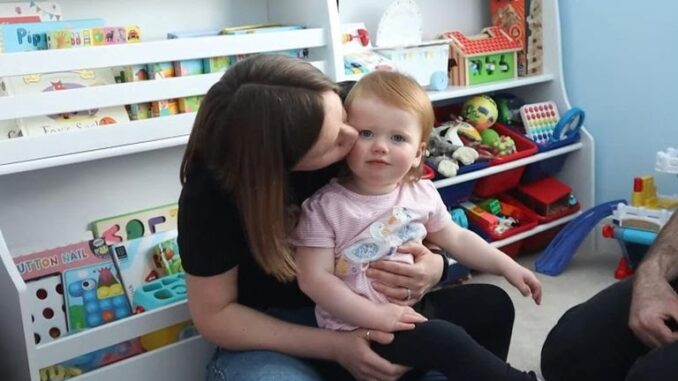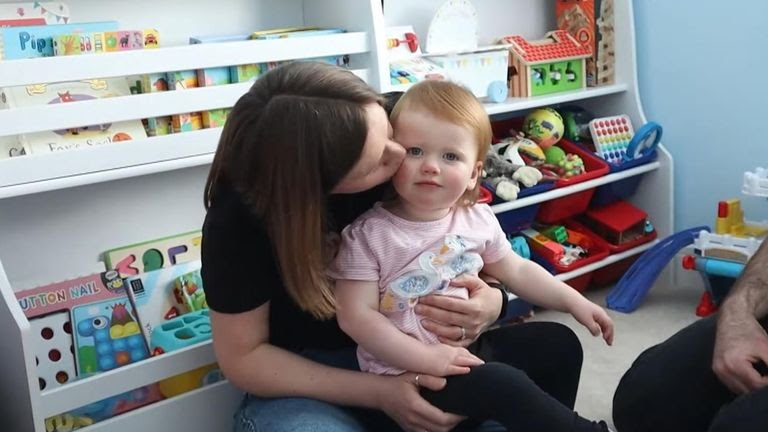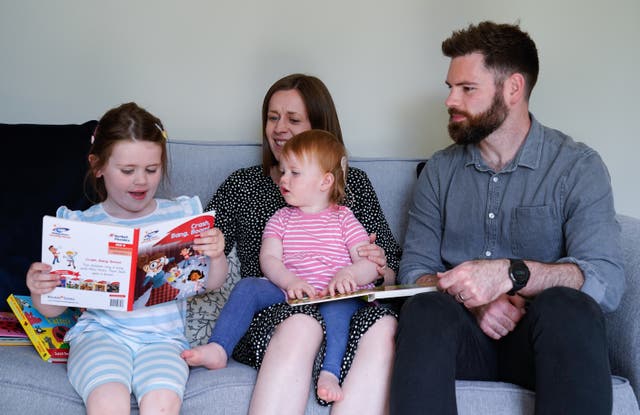

A British girl has had her hearing restored after becoming the first in the world to take part in a groundbreaking new gene therapy trial.
Opal Sandy, aged 18 months, was born completely deaf due to the condition auditory neuropathy, which is caused by the disruption of nerve impulses travelling from the inner ear to the brain.
Now, thanks to a “one and done” gene therapy being trialled in the UK and worldwide, Opal’s hearing is almost normal – and could even improve further.
The little girl from Oxfordshire, who has a genetic form of auditory neuropathy, was treated at Addenbrooke’s Hospital, which is part of Cambridge University Hospitals NHS Foundation Trust.
Professor Manohar Bance, an ear surgeon at the trust and chief investigator for the trial, told the PA news agency the results were “better than I hoped or expected” and may point to a cure for patients with this type of deafness.
He said: “We have results from [Opal] which are very spectacular – so close to normal hearing restoration. So we do hope it could be a potential cure.”
Auditory neuropathy can be caused by a fault in the OTOF gene, which is responsible for making a protein called otoferlin. This enables cells in the ear to communicate with the hearing nerve.
To overcome the fault, the “new era” gene therapy – from biotech firm Regeneron – delivers a working copy of the gene to the ear.
In Opal’s case, she received an infusion containing the working gene in her right ear during surgery last September.
Her parents Jo and James, both 33, noticed improvements to her hearing within four weeks when Opal turned her head to loud clapping.
“When she first turned, I couldn’t believe it,” Mrs Sandy told PA.
“I thought it was a fluke or like a change in light or something that had caught her eye, but I repeated it a few times.
“I picked my phone up and texted James, and said, ‘I think it’s working’. I was absolutely gobsmacked. I thought it was a fluke.”
But even more impressive results were on the horizon.
Some 24 weeks after surgery, in February this year, tests in Cambridge showed Opal could also hear soft sounds such as a whisper.
“The audiologist played back some of the sounds that she was responding to and they were ridiculously quiet sort of sounds that in the real world wouldn’t catch your attention during a conversation,” Mrs Sandy said.
“Certainly since February, we’ve noticed her sister [Nora] waking her up in the morning because she’s running around on the landing, or someone rings on the door so her nap’s cut short.
“She’s definitely responding more to sort of what we would call functional sounds rather than just sounds that we use to test her.
“We were told she had near-normal hearing last time – I think they got responses at sort of 25 to 30 decibels.
“I think normal hearing is classed at 20 decibels, so she’s not far off. Before, she had no hearing whatsoever.”
Prof Bance said Opal’s hearing is now “close to normal”, adding: “We hope she’ll get back to normal by the next testing.”
He added that the treatment is “a one-and-done therapy, so hopefully you have your treatment and then you go back to your life”.
A second child has also received the gene therapy treatment at Cambridge University Hospitals, with positive results seen recently, six weeks after surgery.
The overall phase 1/2 Chord trial consists of three parts, with three deaf children, including Opal, receiving a low dose of gene therapy in one ear only.

A different set of three children will get a high dose on one side. Then, if that is shown to be safe, more children will receive a dose in both ears at the same time.
Up to 18 youngsters from the UK, Spain and the US are being recruited to the trial and will be followed up for five years.
Prof Bance said: “My entire life, gene therapy has been ‘five years away’, and I’ve been in practice about 30 years.
“So, for me, it was almost unreal that this moment had arrived.
“It was just the fact that we’ve been hearing about this for so long, and there’s been so much work, decades of work … to finally see something that actually worked in humans … It was quite spectacular and a bit awe-inspiring really.
“It felt very special.”
At the moment, the gold standard treatment for auditory neuropathy is cochlear implants.
Opal had one fitted to her left ear at the same time as she underwent gene therapy in her right ear, to ensure she got hearing as soon as possible.
The youngster is the first patient globally to receive the Regeneron therapy and “she’s the youngest globally that’s been done to date as far as we know,” Prof Bance said.
China has also been working on targeting the same gene, with positive results, though Prof Bance said theirs uses a different technology and slightly different mode of delivery.
Medics in Philadelphia have also reported a good outcome with a type of gene therapy on an 11-year-old boy, who was operated on after Opal.
Prof Bance said he believes the trial is “just the beginning of gene therapies”, adding: “It marks a new era in the treatment for deafness.
“It also supports the development of other gene therapies that may prove to make a difference in other genetic-related hearing conditions, many of which are more common than auditory neuropathy.”
He said it could take a while for more children to benefit from gene therapy. The treatment was currently not available on the NHS.
“What’s really helped though is that the NHS does pay for genetic testing now for hearing loss,” he said.
Opal Sandy can now hear unaided for the first time (Andrew Matthews/PA Wire)
Opal’s surgery, which was carried out under general anaesthetic, was very similar to fitting a cochlear implant, Prof Bance continued.
“So basically, we find the inner ear and we open the inner ear and infuse the treatment, in this particular case using a catheter, over 16 minutes,” he said.
“We have to make a release hole in another part of the ear to let the treatment out because it has to go all the way through the ear.
“And then we just repair and close up, so it’s actually a very similar approach to a cochlear implant, except we don’t put the implant in.”
Martin McLean, senior policy adviser at the National Deaf Children’s Society, welcomed the study, saying it would lead to learning regarding gene therapies for deafness with a specific genetic cause.
“We would like to emphasise that, with the right support from the start, deafness should never be a barrier to happiness or fulfilment,” he said.
“As a charity, we support families to make informed choices about medical technologies, so that they can give their deaf child the best possible start in life.”
Independent.UK

Leave a Reply